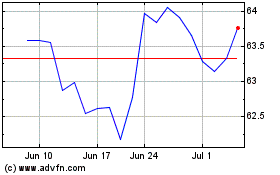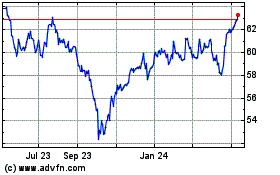By Sarah Chaney
Unemployment fell sharply in August as hiring gains moderated,
showing the U.S. economy continued to recover from the steep
downturn triggered by the coronavirus pandemic.
The U.S. economy added 1.4 million jobs last month, helping push
down the unemployment rate to 8.4% from 10.2% in July, Friday's
Labor Department report said. The jobless rate's decline -- it has
dropped from near 15% in April at the beginning of the pandemic --
put it below the peak from the 2007-2009 recession.
That puts unemployment in line with past major recessions,
though it is significantly higher than pre-pandemic levels. The
jobless rate stood at 3.5% in February, a half-century low, just
ahead of the coronavirus crisis.
State reopenings of their economies helped boost employment this
summer, but the gains have cooled in recent months. The economy is
operating with about 11.5 million fewer jobs than in February.
"The jobs market is clearly out of the ditch and still firmly on
the road to recovery, but slowing," Jim Baird, Plante Moran
Financial Advisors' chief investment officer, said in a note to
clients.
The number of unemployed individuals saying their layoffs were
temporary declined to 6.2 million in August from 9.2 million in
July, indicating many employers are bringing back workers. But the
number of individuals saying their layoffs were permanent rose to
3.4 million last month, a shift from earlier in the pandemic when
more people thought their jobs would return.
Retail and government hiring helped drive August's jobs gains.
Super centers and home improvement stores have seen employment
increase during the pandemic, and other types of retailers,
including department and furniture stores are seeing a rebound
after a deep decline. Meanwhile, Census hiring boosted federal
jobs, while state and local employment has held up relatively well
as the school year gets under way.
Financial markets were mixed. U.S. Treasury yields rose after
the better-than-expected jobs news, while stocks continued a
selloff driven by declines in technology companies.
The economy continues to face uncertainty, with the total number
of coronavirus cases in the U.S. exceeding 6.15 million and
warnings from some governors about persistent risks from the
virus.
Several large companies have warned of job cuts in recent days,
a sign the labor market could face an uneven performance this
fall.
United Airlines Holdings Inc. said Wednesday it plans to cut
16,370 staff amid a pandemic-driven slump in passenger demand.
Coca-Cola Co. said last week it plans to lay off some
employees.
Economists say new company layoffs reflect a shift in employers'
mentality from earlier in the crisis, when many expected shutdowns
would be over in a matter of weeks.
"If you are laying people off now, you kind of know that this
situation isn't going anywhere any time soon," said Martha Gimbel,
economist at Schmidt Futures, a philanthropic initiative. "It is
highly likely that any layoffs that are happening now are intended
as permanent."
Unemployment rates for Black, Hispanic and white workers fell in
August, while holding steady for Asian workers, the Labor
Department said. Joblessness is lowest among white Americans --
7.3% -- and remained above 10% for Black, Hispanic and Asian
workers, pointing to divergent economic outcomes from the pandemic.
The unemployment rate for those without a high-school degree was
12.6%, while workers with a bachelor's degree or higher were
unemployed at a 5.3% rate.
BluePearl Pet Hospital, a network of veterinary medicine
hospitals across the country, is in hiring mode, thanks to a sharp
rise in demand for vet services, said Jimmy Barr, the company's
chief medical officer. He attributes the increase in vet visits, in
part, to a rise in pet ownership during the pandemic.
Individuals working from home are spending more time with their
pets during quarantine and have more flexibility to seek care, Mr.
Barr said.
The share of Americans working or seeking work rose in August to
61.7% from 61.4% in July and a pandemic low of 60.2% in April. More
individuals looking for work bodes well for job growth and the
broader economic recovery.
Shelby Burnette, age 19, started searching for work this
summer.
The Newport News, Va., resident was laid off from her part-time
job at a clothing store this spring. She held off on immediately
applying for jobs because she didn't feel safe returning to work
given that a pre-existing lung condition put her at higher risk
from the effects of the virus.
Ms. Burnette said she began filling out job applications online
in June because she wouldn't be able to financially sustain herself
once the extra $600 a week in unemployment benefits expired at the
end of July. Job prospects were slim, though.
"When I would apply, I wouldn't hear anything back or sometimes
there wasn't anything to apply to. It was kind of like, 'What am I
supposed to do?'" Ms. Burnette said.
About a month ago she was hired to help supervise children at a
local day-care center. She said she hopes to find another job with
a higher wage soon.
Some companies that reopened in late spring and early summer
hired back a portion of their furloughed workers but aren't seeing
enough demand to bring employment back to precrisis levels.
Faust Hotel and Brewing Co. laid off all employees except for
managers when it temporarily closed at the onset of the pandemic.
The New Braunfels, Texas, company slowly brought back workers for
its reopening at the end of spring, said McKenna Lewis, the hotel's
guest-services coordinator.
Faust is still operating with less staffing than before the
economic crisis hit earlier this year, and Ms. Lewis doesn't expect
it to ramp up hiring. Hotel reservations were hurt by a decline in
tourist traffic this summer. Business likely won't pick up soon,
especially now that Wurstfest is canceled, Ms. Lewis said, noting
the German-sausage and drinking festival boosted New Braunfels's
fall tourism in pre-pandemic times.
"Ultimately we're just trying to remain hopeful that people want
to see us survive," she said.
Write to Sarah Chaney at sarah.chaney@wsj.com
(END) Dow Jones Newswires
September 04, 2020 12:00 ET (16:00 GMT)
Copyright (c) 2020 Dow Jones & Company, Inc.
Coca Cola (NYSE:KO)
Historical Stock Chart
From Mar 2024 to Apr 2024

Coca Cola (NYSE:KO)
Historical Stock Chart
From Apr 2023 to Apr 2024
